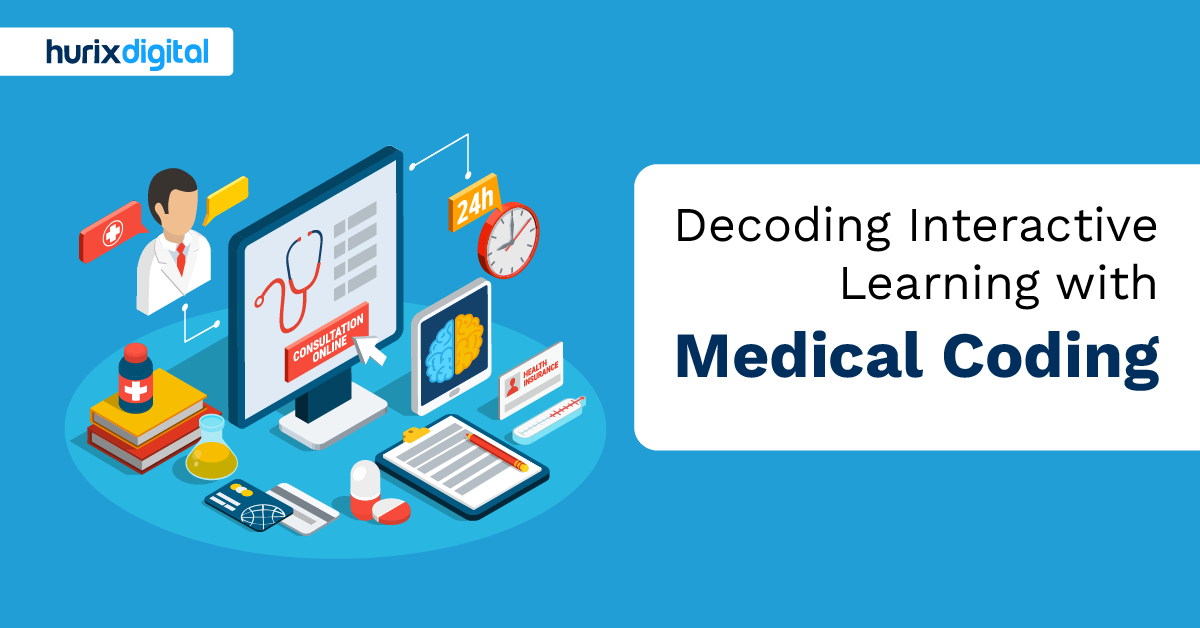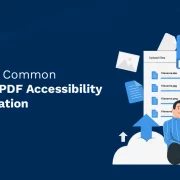
Decoding Interactive Learning with Medical Coding
Summary
This blog explores interactive medical coding courses, highlighting features, benefits, certification importance, career prospects, and guidance on choosing the right institution for medical coding education.
When it comes to starting a career in medical coding, selecting the right certification course is key. It not only ensures you receive proper training but also enhances your job prospects and career opportunities in the healthcare industry.
To make sure you choose the best medical coding certification course for your career goals, take the time to thoroughly research and evaluate your options and review feedback and recommendations.
With the swift advancement in AI and ML, where jobs are scarce, a career in medical coding ensures job security. In fact, as per the Bureau of Labor Statistics, the job opportunity for healthcare information technicians may increase by 8% from 2022 to 2032.
With that being said, let’s talk about the medical coding career – one of the most satisfying and in-demand careers in this domain – and understand its ins and outs.
In this post, we’ll discuss all about medical coding. Read on!
Table of Contents:
- What is Medical Coding?
- What is the Role of Medical Coders in Healthcare?
- The Rise of Interactive Learning of Medical Coding
- Features of Interactive Medical Coding Courses
- Benefits of Interactive Medical Coding Courses
- Why can a Career in Medical Coding be Excellent?
- The Importance of Medical Coding Certification
- Coding Career Development and Advancement
- How to Choose the Ideal Medical Coding Institution?
- Ensure Accreditation
- Explore Comprehensive Course Content
- Verify Instructor Qualifications
- Assess Available Student Support
- Evaluate Cost and Financial Assistance Options
- Consider Flexibility and Convenience
- Review Job Placement Support Services
- Consider Continuing Education Opportunities
- Research Industry Connections and Partnerships
- Takeaway
What is Medical Coding?
Also known as healthcare coding, medical coding refers to the technical process of converting healthcare information into alphanumeric codes. This includes medical details about diseases, injuries, procedures, and so on.
Various medical coding systems are used worldwide. Some of the most popular ones include the International Classification of Diseases (ICD), the Current Procedural Terminology (CPT), and the Healthcare Common Procedure Coding System (HCPCS).
What is the Role of Medical Coders in Healthcare?
The use case of medical coding is immense. So, if you’re wondering how you can implement this skill, here is your answer:
1. Clinical Documentation Improvement (CDI)
Perhaps one of medical coding’s most important roles is Clinical Documentation Improvement (CDI). Medical coding is used for summarizing and documenting patient encounters in alphanumeric codes. This includes briefing about diseases, diagnoses, procedures, treatment, and so on. The entire process ensures accurate clinical documentation and improves the quality of patient care.
2. Legal Compliance
Regulatory bodies like the Centers for Medicare and Medicaid Services (CMS) have established certain guidelines and instructions on medical coding. This is to enforce legal compliance and reduce the chances of fraud in healthcare. Therefore, proper medical coding also plays a significant role in ensuring compliance, preventing fraud, and helping healthcare organizations avoid legal issues.
3. Revenue Cycle Management
Accurate medical coding is also vital for proper revenue cycle management in healthcare facilities. These codes reflect the amount entitled to every healthcare provider that ensures they receive proper reimbursement in return for their service. Additionally, medical coding plays a huge role in timely claim processing, reducing claim denials, and enhancing cash flow within the healthcare organization.
4. Collaboration
Medical coders operate closely with different departments in a healthcare institution, such as the billing department, staff, etc. They also get in touch with insurance companies to develop accurate codes. This collaborative approach prevents coding-related issues, such as coding errors, unbundling, upcoding, and undercoding. Moreover, it also proves fruitful in establishing a seamless, efficient healthcare administration.
5. Research and Analysis
Medical coding provides researchers with the base data to conduct studies and research around a topic. This facilitates the identification of trends, patterns, effects, results, diagnoses, methods, treatments, etc., of a certain disease. Needless to say, this incredibly expedites healthcare innovations and improves the quality of medical services.
The Rise of Interactive Learning of Medical Coding
As a result of the realization that medical coding education needs to be more dynamic and interesting, interactive courses have become an invaluable resource for today’s students. These classes make use of technology to provide an interactive learning environment that goes beyond the limitations of conventional textbooks.
Learners can gain practical medical coding skills necessary for advancement through blended learning in healthcare that includes interactive exercises, multimedia tools, and real-world case studies.
Features of Interactive Medical Coding Courses
The various aspects of interactive medical coding courses that enhance the learning outcomes and requisite skills of coding students are as follows:
1. Multimedia Resources
Multimedia content like movies, animations, and audio recordings are used in engaging medical curricula to improve the educational process. By reinforcing difficult concepts, visual and auditory aids improve the material’s engagement and comprehension.
Watching a video demonstration of coding techniques can help learners gain hands-on knowledge of applying codes in real-world scenarios.
2. Interactive Exercises and Simulations
Interactive exercises and simulations are crucial components of medical coding courses. Through these exercises, students can get experience assigning codes, navigating case scenarios, and receiving immediate performance feedback.
Additionally, students can enhance their efficiency and accuracy in coding while obtaining important experience in a mock healthcare setting.
3. Real-World Case Studies
Real-world case studies are frequently included in interactive courses to assist students in applying their knowledge of coding to real-world scenarios. Learners are required to accurately analyze and code complex patient scenarios, medical records, and billing information presented in these case studies.
Through completing these case studies, students strengthen their critical thinking abilities and gain experience navigating the challenges of practical coding exercises.
4. Collaboration and Discussion Forums
Discussion forums and collaboration tools in interactive courses facilitate peer-to-peer interaction and communication. Students can interact with their peers through discussions, questions, and insight sharing, fostering a collaborative learning environment.
Peer-to-peer learning facilitates the acquisition of diverse viewpoints, idea sharing, and a deeper comprehension of medical coding concepts.
Benefits of Interactive Medical Coding Courses
Interactive medical coding courses meet the various needs of contemporary learners by providing a thorough and engaging learning environment. Here are some of its top-rated benefits:
1. Increased Engagement
Interactive medical coding courses aim to maintain students’ motivation and engagement throughout their learning process.
These courses offer a more immersive learning experience that caters to a variety of learning styles by incorporating interactive elements like simulations, quizzes, and multimedia content.
2. Practical Experience
Engaging in hands-on practice is one of the main benefits of interactive courses. Students can practice assigning codes, apply their knowledge in practical situations, and get fast performance feedback.
This hands-on experience helps students develop their confidence in their coding abilities while also reinforcing what they have learned.
3. Instant Evaluation and Progress Monitoring
Students enrolled in interactive courses can monitor their progress over time and pinpoint areas for betterment by receiving immediate feedback on their assignments.
Real-time feedback can be helpful for learners who want to identify their abilities and shortcomings and modify their study strategies accordingly.
4. Flexibility and Accessibility
With interactive medical coding courses, learners can study at their speed and on their schedule. Thanks to the availability of course materials on a wide range of devices, learning coding skills is now easier and more readily available than ever.
5. Relevant and Updated Learning Resources
It’s critical to stay up to date on the most recent coding guidelines and industry trends in a field as dynamic as medical coding.
Interactive courses are regularly updated to keep up with changes in laws and current standards to ensure that students receive the latest and most relevant knowledge to help them thrive in their careers.
Why can a Career in Medical Coding be Excellent?
A career in medical coding offers a list of benefits over other occupations. So, if you belong to the healthcare industry, here’s why you should consider this profession:
1. Strong Demand
As of 2024, medical coding is one of the most in-demand professions in the healthcare domain. As per a report by Grand View Research Inc., by the end of 2025, the global medical coding market is estimated to surpass $25.4 billion in size. This highlights the constant need for seasoned medical coders in the industry.
2. Better Job Stability
Healthcare services never witness a plunge. Generally, their need remains consistent even if the country’s economy undergoes a recession. This makes the medical coding career an exceptionally stable one. In fact, as the involvement of technology in the healthcare sector grows, so will the need for expert healthcare coders. So, if job security is a priority for you, go for medical coding.
3. Incredibly Flexible
Unlike other professions in the healthcare industry, medical coding is a fully flexible one. As a medical coder, you have the luxury to work from any setting – home or office and don’t have to relocate to a new place for your job. This makes the profession a highly desirable one, especially for people who have certain restrictions.
4. Professional Development Opportunities
Medical coding offers several professional development opportunities to a candidate. After pursuing your medical coding certification, you can earn additional certifications and credentials in coding auditing, healthcare compliance, etc., to enhance your CV. Moreover, you can also move abroad to explore better opportunities or work remotely for a reputed international organization.
5. Highly Satisfying
The absence of an efficient healthcare infrastructure can adversely impact the society. Since medical coding forms a significant part of that infrastructure, this realization helps medical coders feel satisfied and significant in their jobs. Moreover, it motivates them to execute their work with sheer dedication and meticulousness.
The Importance of Medical Coding Certification
A certification in medical coding verifies an individual’s capacity to understand the elaborate knowledge of healthcare coding. Certification serves as evidence of a coder’s proficiency in precisely translating medical records into internationally accepted codes, corresponding with the complexity of medical terminology and procedures.
For instance, the American Academy of Professional Coders, or AAPC certification, and the American Health Information Management Association, or AHIMA certification, are the two main certifications that evaluate a candidate’s proficiency in medical coding in the USA.
Credentialed specialists can work in fields such as consulting, revenue cycle management, and healthcare administration in addition to conventional coding jobs. Coders can pursue leadership roles in healthcare organizations and broaden their career prospects by obtaining other skills and certifications.
Coding Career Development and Advancement
Workshops, seminars, and conferences are examples of professional development options that offer beneficial networking and exposure to medical coding advancements and trends. Additionally, programmers can access resources, engage in continuing education activities, and network with colleagues in the business by joining professional associations like the AHIMA and AAPC.
Getting more certificates shows that you’re dedicated to learning new things and growing in your career. Obtaining specialized qualifications in medical auditing, risk adjustment, and outpatient coding can boost employment prospects and income.
By making continual educational and professional development investments in their field, coders can set themselves up for long-term success and career progression.
How to Choose the Ideal Medical Coding Institution?
To guarantee an excellent educational experience, several variables should be taken into account when choosing a medical coding school. Analyzing student results might reveal important details about the standing and efficacy of the institution.
1. Ensure Accreditation
A coding school’s accreditation guarantees that it upholds the highest levels of academic rigor and quality.
Accrediting agencies subject accredited programs to extensive review processes in which they assess curriculum relevancy, student results, faculty qualifications, and other variables. Students who enroll in an approved coding school are certain to acquire a quality education that employers and the industry as a whole value.
2. Explore Comprehensive Course Content
An extensive curriculum should encompass fundamental medical coding subjects, including anatomy and physiology, medical terminology, coding requirements, and healthcare legislation.
Opportunities for practical experience and hands-on instruction are also crucial for the development of coding expertise and confidence.
3. Verify Instructor Qualifications
Skilled educators possessing industry experience can provide insightful analysis, useful advice, and real-life examples to improve the educational process.
To make sure they receive education from certified specialists, prospective students should investigate the credentials, professional backgrounds, and teaching experience of their instructors before enrolling in a coding program.
4. Assess Available Student Support
Academic counseling, career counseling, and tutoring are examples of student support services. The success of its students is a priority for coding schools, and they show this by offering resources to help students overcome obstacles and reach their academic and professional objectives.
5. Evaluate Cost and Financial Assistance Options
When selecting a medical coding school, potential students take cost into account.
The cost of tuition varies greatly among schools and programs. You should also account for other charges, including textbooks, exam fees, and certification fees. It’s necessary to assess the program’s overall cost and look into funding possibilities, including grants, scholarships, and payment plans, before enrolling in a coding school.
6. Consider Flexibility and Convenience
Online medical coding training programs are perfect for busy individuals or working professionals, as they let students learn at their speed.
To improve the learning process, a lot of online courses also include interactive modules, practice questions, and simulation training. In conventional learning environments, students gain from direct communication with teachers and fellow students.
Classroom-based programs offer extra resources like labs and libraries. These programs, however, could have more rigid schedules and require students to commute, which might not be an option for everyone.
7. Review Job Placement Support Services
Numerous coding schools provide job placement services to assist graduates in finding entry-level jobs in the industry. These services could include help with writing resumes, interview preparation, and connections with possible employment. If you are interested, try to find out how many alumni of the coding school are placed in jobs and what kinds of support services are offered to them.
8. Consider Continuing Education Opportunities
Explore whether the coding institution offers opportunities for continuing education and professional development.
A reputable institution should provide avenues for graduates to pursue advanced certifications or specialized training to enhance their skills further and stay updated with industry trends. Continuing education options can significantly contribute to long-term career growth and advancement in medical coding.
9. Research Industry Connections and Partnerships
Look into the institution’s industry connections and partnerships within the healthcare sector. A coding school that collaborates with hospitals, clinics, or healthcare organizations may offer unique opportunities for internships, externships, or practical experience placements.
These connections can provide valuable hands-on training and networking opportunities, ultimately enhancing your readiness for the job market and increasing your chances of securing employment after graduation.
Takeaway
As the demand for qualified medical coders grows, there is a pressing need for creative and interesting learning materials. Medical coding courses provide a cutting-edge and efficient method of instruction to help prospective coders gain the knowledge and skills necessary to succeed in this fast-paced industry.
If you are looking for EdTech solutions to create ingenious medical coding courses, Hurix Digital is your perfect partner! Make use of our expertise to offer students engaging educational materials. We employ various immersive media solutions to raise overall learner engagement and retention rates.
Want to learn more? Contact us today!

Senior Vice President – Business Development
Over 25 years of experience in the edtech and workforce learning industry with strong skills in Business Development, Customer Relationship Management (CRM) and Strategy.



